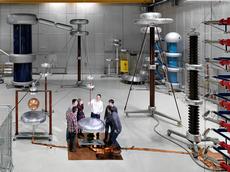An energy compass for ETH Zurich
When it comes to using energy, ETH Zurich is keen to make a more conscious effort to play to its strengths in future. This approach is underlined by the new ETH Zurich Energy Concept, which the Executive Board is set to put into effect on 1 January 2013.

Energy supply in Switzerland is about to undergo some radical changes, as the gradual phase-out of nuclear energy is now one of the Swiss government’s most important and ambitious objectives.
However, with nuclear energy currently accounting for
a substantial 38 percent of Switzerland’s power consumption, there is still a
long way to go before this goal can be achieved. ETH Zurich is in an ideal
position to drive forward a reform of the energy system, not only through
education and fundamental research, but also by proposing concrete solutions
for improving the efficiency, transmission, storage and provision of energy.
Over the past few years, the university has systematically stepped up its
energy research as a matter of priority.
At the same time, it has also further developed and enhanced its own energy supply system. One notable result of this is the innovative underground storage system on the Hönggerberg campus, which has been put into operation over several stages since last summer and enables heating and cooling with practically no CO2 emissions.
A united front following debate on power supply
These new developments prompted a review of ETH
Zurich’s old Energy Concept, which had been in place for over a decade. Moreover,
a decision made by the Executive Board in 2010 has recently met with criticism
from ETH Zurich students and some politicians. It had decided to revert back to
a system with a high proportion of power supplied by nuclear energy, with the
aim of saving some 800,000 Swiss francs per year to be invested directly in
energy research. The Executive Board is convinced that this approach, rather
than indirectly promoting environmentally friendly methods of generating power
through green energy premiums, will enable it to make a significantly greater contribution
towards the transformation of the energy system.
Following two intensive rounds of discussions, ETH Zurich President Ralph Eichler invited students from the “Working group on renewable energy at ETH Zurich” (“Arbeitsgruppe für erneuerbare Energie an der ETH”) to take an active part in revising the Energy Concept. This offer was enthusiastically accepted, and a working group of students, professors, university staff and business representatives set to work on this task in January 2012 under the leadership of ETH Zurich Environmental Officer Dominik Brem. The group has since met on seven occasions and held controversial discussions to seek and ultimately reach a consensus. The new Energy concept is now complete, and the Executive Board will implement it at the beginning of 2013.
Conflicts of interest addressed
The Energy Concept consists of three parts. The
preamble is followed by a list of a dozen guiding principles, which illustrate where
and how ETH Zurich intends, in principle, to tackle energy-related issues. The
key focus here is on maintaining a high standard of fundamental research into
sustainable energy supply, teaching the latest knowledge and ensuring exemplary
energy efficiency in ETH Zurich’s own infrastructure.
An important matter raised in the guiding principles is that of conflicts of interests, which a university like ETH Zurich is likely to face in relation to this topic and will have to take into consideration. As Dominik Brem, who is leading the working group, explains: “The most significant conflicts of interest are explicitly addressed in the document”.
Examples of the kinds of conflicts of interest expected include:
- Growth and development versus energy use;
- ETH Zurich’s global orientation versus the CO2 emissions produced by mobility;
- Technical feasibility versus finances.
A group of experts is to advise the Executive Board on any decisions regarding such conflicts of interest.
Alignment with the Swiss energy mix
The second part – and the centrepiece – of the Energy
Concept presents specific areas for action with clear declarations and
objectives, intended to ensure that the Energy Concept can be implemented in
practice. “These areas for action should provide the impetus for measures to be
taken,” claims Dominik Brem, who goes on to add: “It is extremely important
that these measures are presented in a transparent way and that progress is
documented”.
Such measures include, for example, introducing the topic of
sustainable energy supply in study programmes at the earliest possible stage
and with a disciplinary emphasis, and using awareness-raising schemes and
incentives to motivate employees and departments to act in an energy-efficient
way and make an effort to save energy.
As far as its infrastructure is concerned, ETH Zurich is aiming to rapidly reduce CO2 emissions and increase the proportion of renewable energy used. In concrete terms, the university intends, starting from 2013, to align its power consumption with the average Swiss energy mix, with the proportion of nuclear power in this mix having fallen from its previous level of around 70 percent to approximately 40 percent.
The third and final part of the Energy Concept describes
the aim for development with regard to energy indicators, such as total energy
and power consumption or CO2 emissions. The targets set by the “Energy Future
for Switzerland” study conducted by ETH Zurich in November 2011 are taken into consideration
here, based on the number of employees and students (a “per capita” approach).
Taking into account the technical and financial resources available, the proportion of energy supplied from renewable sources should continuously increase, or at least at the same rate as in the Swiss energy mix.







READER COMMENTS